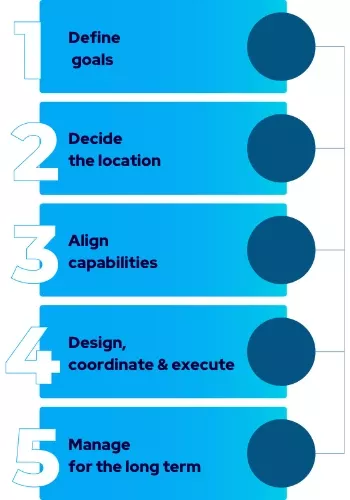Colocation strategy guide: 5 steps to build an effective plan
A strong colocation strategy helps organizations deliver reliable services, keep teams productive, and support long-term growth.

As businesses become more dependent on IT, planning for where and how infrastructure is housed has become a critical decision. The right colocation strategy aligns your business goals with the strengths of a colocation services provider, ensuring uptime, scalability, and cost control.
What is colocation? In short, it’s a model where you place your IT infrastructure inside a secure, professionally managed data center operated by a third party. But choosing the right colocation data center (and building a strategy around it ) requires careful planning.
This guide outlines five steps for building an effective colocation strategy, along with key evaluation criteria, FAQs, and a real-world example of how Flexential supports enterprise growth.
Why organizations need a colocation strategy
Modern organizations run on IT infrastructure. If systems fail, productivity, customer experience, and revenue all suffer. A colocation strategy ensures your infrastructure is not just housed securely but also positioned to meet evolving needs such as AI workloads, disaster recovery, and regulatory compliance.
Colocation offers benefits like:
- High reliability: SLA-backed uptime and redundant power/network connections.
- Scalability: Room to grow without building a data center.
- Security and compliance: Advanced physical security and certified compliance frameworks.
- Cost efficiency: Lower TCO compared to building and managing your own facilities.
- Agility: Access to interconnection, cloud on-ramps, and value-added services.
Because no two organizations have the same priorities, your colocation strategy should map data center capabilities to your specific goals, growth plans, and operational requirements.
How to build an effective colocation strategy
Step 1: Define organizational goals
Start with the big picture. Identify your business objectives and the IT services needed to achieve them. Consider:
- Expected growth (users, workloads, regions).
- Budget and cost controls.
- Hardware and connectivity requirements.
- Business continuity, security, and compliance needs.
Confirm that colocation is the right deployment model to meet these goals, and get buy-in from leadership early. A strategy built on shared objectives avoids misalignment later.
Step 2: Decide on a data center facility location
The physical site of your colocation facility directly affects latency, disaster recovery (DR), accessibility, and cost. When evaluating location:
- Proximity to users and teams: For low-latency delivery or frequent on-site access.
- Disaster recovery: Look for providers with geo-diverse sites and strong DR solutions.
- Cost considerations: Some markets, like Northern Virginia or Silicon Valley, command premium prices.
- Expansion potential: A provider with multiple sites can simplify future growth.
Step 3: Align colocation provider capabilities with organizational needs
Not all colocation providers are equal. Assess whether they can deliver:
- Proven reliability and uptime track record.
- Security and compliance certifications that meet your industry requirements.
- Scalability across power, cooling, and space.
- Connectivity options: carrier neutrality, cloud on-ramps, interconnection.
- Expert support and managed services, if needed.
Visiting facilities and meeting the operations team gives valuable insight into how well the provider manages its environment.
Step 4: Design, coordinate, and execute the colocation solution
Migration is the most hands-on part of a colocation strategy. Build a plan that covers:
- Infrastructure audit: Consolidate resources and refresh outdated equipment.
- Migration checklist: Log and label hardware, confirm backups, test DR plans.
- Deployment approach: Choose between a phased migration or single cutover.
- Scheduling: Limit disruption by moving during off-hours or low-traffic periods.
Leverage your provider’s expertise for project management and technical guidance. Many providers offer remote hands, managed services, and on-site teams to support a smooth transition.
Step 5: Manage the relationship for the long term
A colocation strategy doesn’t end after migration. Business priorities, workloads, and compliance requirements will evolve. Maintaining an open, collaborative relationship with your provider ensures you can:
- Scale space, power, and bandwidth as needed. Ask: Can the provider deliver capacity within your required timeline?
- Integrate new services like managed security or DRaaS. Ask: Do they offer services that reduce the need for additional vendors?
- Stay ahead of technology shifts such as AI and edge computing. Ask: Does the provider share forecasts and recommendations for adapting infrastructure?
- Continuously optimize for performance and cost efficiency. Ask: Are regular reviews built into the partnership to reassess costs, compliance, and service quality?
Case study: How Wasabi scaled with a strong colocation strategy
Cloud storage disruptor Wasabi needed a partner to support explosive growth and a strategic West Coast expansion. Their requirements included reliability, connectivity, environmental safeguards, and cost-effectiveness.
Wasabi chose Flexential colocation, gaining high-density facilities, advanced power and cooling (including liquid cooling), and versatile connectivity. Beyond infrastructure, Flexential provided proactive planning, even forecasting future capacity needs before AI workloads surged.
The results:
- Performance: Next-gen colocation maximized speed and reliability.
- Efficiency: Better planning for power and space supported forward-looking investments.
- Focus: Flexential handled infrastructure, so Wasabi could focus on cloud storage innovation.
“The technical capabilities Flexential offers are crucial, but what truly sets our partnership apart is the strong human relationship we’ve developed. It’s not just about managing our data center; it’s about having dedicated team members who are actively looking to enable and grow our business.” — Vin Antarkar, VP Operations, Wasabi
This example highlights how the right colocation strategy, backed by the right partner, enables sustainable growth and competitive advantage.
Flexential: Your ideal strategic colocation data center partner
With more than 40 interconnected data centers across 19 U.S. markets, Flexential delivers the reliability, scalability, and security needed for enterprise growth. Our colocation services provider portfolio spans single cabinets to multi-megawatt deployments, backed by SLA guarantees and deep compliance expertise.
Our retail vs wholesale colocation options provide flexibility for every IT footprint. And our data center sustainability initiatives — including 4th and 5th-generation designs — ensure efficiency for the future.
At Flexential, we go beyond infrastructure. Our team works closely with you to design, implement, and evolve a colocation strategy that aligns with your goals and supports long-term growth.
Explore our colocation resources and contact us today to start planning your strategy.
How to choose the best data center for colocation: FAQs
Does the colocation data center offer the necessary reliability?
Look for SLA-backed uptime, redundant systems, and a track record of availability. The Uptime Institute offers data center tiers that designate uptime capabilities, ranging from Tier 4 data centers with only 26.3 minutes of downtime yearly to Tier 1 data centers with 28.8 hours of downtime yearly. This information can help organizations narrow their options.
Can the colocation solution scale with changing needs?
Yes, but confirm that the provider offers flexible power, space, bandwidth, and managed services.
Are robust connectivity options available?
Carrier neutrality, interconnection fabrics, and cloud on-ramps are essential.
Does the colocation provider offer multiple locations?
A provider with geo-diverse sites can support expansion and disaster recovery.
Is it cost-effective?
Cost should align with services. The most expensive facility isn’t always the best fit.
Can the colocation provider serve as a partner?
The best providers act as collaborators, not just vendors.
Does it offer the necessary security and compliance?
Verify certifications such as ISO 27001, SOC reports, HIPAA, and PCI DSS.








